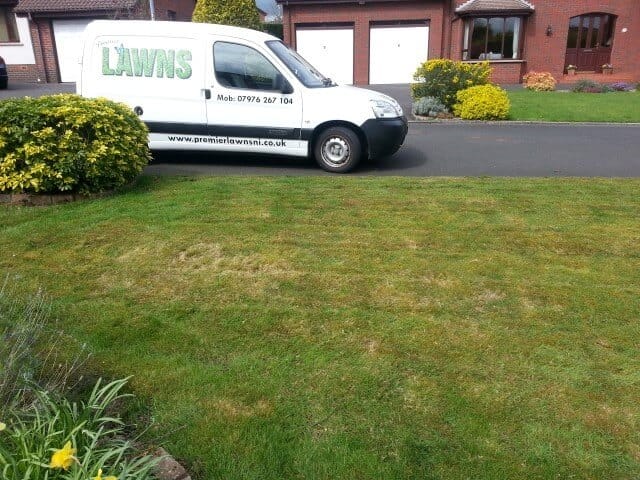A weed is simply a plant in the wrong place. But how do you get rid of common lawn weeds without ruining your lawn? More importantly, how do you stop them from coming back? The answers are in this article.
What is a lawn weed?
Weeds in general are plants in the wrong place at the wrong time. A lawn weed is any plant that you don’t want growing in your lawn. Even some species of grass can be a lawn weed.

Weeds change the appearance of your lawn. Instead of a nice even colour and texture, you will see odd splodges or patches that spoil the uniformity. You might not notice them all of the time, but when any of the plants are under stress (eg during a dry summer) it will be very obvious indeed where the weeds have been lurking.
Of course some people like to see daisies etc in the lawn. They’re great for bees but they do compete with the grass plants for water, nutrients and light. Some of the most vigorous weeds can even crowd the grass out completely.
Annual Meadow Grass
Annual Meadow Grass (Poa annua) is a sneaky sort of lawn weed. As the name suggests, it’s a grass and that allows it to hide amongst the desirable grasses in your lawn for most of the year. This is the grass species that you’ll find growing in cracks in the pavement or popping up uninvited in your flower beds.
Why is AMG a lawn weed?
Because the grass blades are thicker than most lawn grasses and when under extreme stress it becomes very pale in colour.
How will you know it’s there? The tell-tale sign is pale green splats of coarse leaved grass that give your lawn a polka dot effect. In a family lawn it’s unsightly, in a fine lawn it ruins the look of it. Believe me, my greenkeeping career involved quite a lot of trying to manage Annual Meadow Grass invasions on the golf greens.

How to manage Annual Meadow Grass in a lawn
Herbicides are very expensive so the Premier Lawns treatment of Annual Meadow Grass is mainly preventative. Our number one defence is keeping up to date with lawn treatments. Keeping your lawn healthy and stress free will mean there’s no bare patches for AMG to grow in. It also makes it easier to disguise the weed if it does manage to infiltrate. If we do spot AMG while we’re mowing or applying lawn treatments, we’ll let you know and discuss the options with you.
Common Daisy
Everyone loves a daisy. Just not always in the lawn. Luckily these plants are easily controlled with herbicides.

If daisies are a problem in your lawn, give me a call. A well timed application of professional weedkiller will zap the offenders without damaging any other plants in the garden.
Dandelion
Probably the most recognisable lawn weed there is. The dandelion is a real lawn lover and that great big long taproot is a devil to get rid out. Leave as little as half a centimetre of root alive in the ground and it will re-grow. 10/10 to mother nature for building such a resilient plant but like most plants, there’s a time and a place for these yellow perils.
For an occasional dandelion I would recommend digging the plant out as soon as you see it.– and definitely before it sets seed. Alternatively, if you are confident using weedkillers, spot treat each plant with a systemic herbicide such as glyphosate. Be careful though – if you splash it anywhere it will kill any plant it touches.
If your lawn is infested, there are lawn treatments that will eradicate the plants and kill the tap roots too. For best results, ask for professional help. Lawn care professionals are licenced to use really effective herbicides that are stronger and more effective than the ones you’ll find in the garden centre
Moss
Moss is probably the most prolific of all lawn weeds. Managing moss is a major reason for most of the lawn treatments offered by Premier Lawns. In fact moss treatment is so important that it has a dedicated page on our website.

Learn more about moss in lawns
Controlling lawn weeds
Weed control in lawns involves
- Treating weeds as they appear
- Preventative management
At Premier Lawns we use professional grade herbicides in carefully measured doses to control the weeds in your lawn as they appear. We do not believe in using herbicides unless they are needed. If we do need to apply weedkiller we are sure to comply with all current guidelines to protect the environment, you, your pets and of course our operatives.
How to prevent weeds invading your lawn
It’s almost impossible to stop all weeds invading your lawn. Mother Nature hates a monoculture and she’’’ try all sorts of tricks to get as many plant species as possible into an area – as lawn lovers, it’s up to us to second guess her and stop it happening.
- Regular scarifying will remove some of the weed seeds that are harboured in the thatch layer of your lawn.
- Mowing little and often to the best height for your lawn will discourage some types of weed because they don’t like having their heads cut off.
- Feeding your lawn and keeping it healthy will mean that the grass sward is too dense for other plants to invade.
- Vigilance and spot treating weeds as they appear will stop one weed turning into a marauding army of invaders.
- Managing drainage and shade will help to keep moss at bay
- If your lawn is affected by drought in summer, put a drought recovery plan in place ASAP
Help with lawn weeds
If you are faced with a weedy lawn and don’t know where to start, call me. I’m happy to visit lawns in and around Belfast to help identify weeds and recommend treatments.
Further reading
Case study – How Premier Lawns improved a Glengormley lawn troubled by moss
How often should you feed your lawn and apply lawn treatments for weeds?
Treat your lawn with our lawn feed and weed treatments
Weed grasses – what are they and how do you get rid of them? Watch Robbie’s video here
